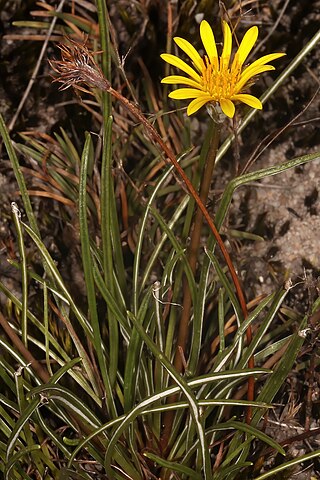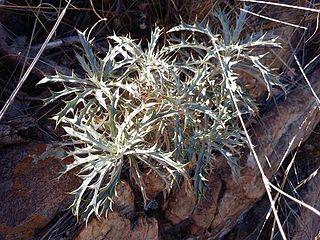
Felicia amelloides, the blue daisy bush or blue felicia, is a hairy, soft, usually perennial, evergreen plant, in the family Asteraceae. It can be found along the southern coast of South Africa. It grows as ground cover and produces many very regular branches. It mostly grows to about 50 cm (1.6 ft) high, rarely to 1 m. The leaves are oppositely arranged along the stems, dark green in colour and elliptic in shape. The flower heads sit individually on up to 18 cm (7 in) long, green to dark reddish stalks. They consist of about twelve heavenly blue ray florets that surround many yellow disc florets, together measuring about 3 cm across. It is also cultivated as an ornamental, and was introduced in Europe in the middle of the 18th century.

Gazania linearis is a species of flowering plant in the family Asteraceae, with thin linear leaves, native to South Africa.

Phaneroglossa is a genus of plants that is assigned to the daisy family. It consists of only one species, Phaneroglossa bolusii, a perennial plant of up to 40 cm high, that has leathery, line- to lance-shaped, seated leaves with mostly few shallow teeth and flower heads set individually on top of long stalks. The flower head has an involucre of just one whorl of bracts, few elliptic, white or cream ray florets, and many yellow disc florets. It is an endemic species of the Western Cape province of South Africa. Flowering mainly occurs from November to January.

Gorteria is a genus of small annual herbaceous plants or shrubs, with 8 known species, that is assigned to the daisy family. Like in almost all Asteraceae, the individual flowers are 5-merous, small and clustered in typical heads, and are surrounded by an involucre, consisting of in this case several whorls of bracts, which are merged at their base. In Gorteria, the centre of the head is taken by relatively few bisexual and sometimes also male, yellow to orange disc florets, and is surrounded by one complete whorl of 5–14 infertile cream to dark orange ray florets, sometimes with a few ray florets nearer to the centre. None, some or all of them may have darker spots at their base. The fruits remain attached to their common base when ripe, and it is the entire head that breaks free from the plant. One or few seeds germinate inside the flower head which can be found at the foot of plants during their first year. The species flower between August and October, except for G. warmbadica that blooms mostly in May and June. The species of the genus Gorteria can be found in Namibia and South Africa.

Gazania krebsiana is is a species of flowering plant in family Asteraceae. It is a low-growing herbaceous perennial native to Southern Africa, ranging from Angola, Zambia, and Mozambique to South Africa. It is one of some 19 species of Gazania that are exclusively African and predominantly South African - only Gazania krebsiana subsp. serrulata (DC.) Roessler ventures northwards from the Transvaal into tropical Africa.

Berkheya carlinopsis Welw. ex O.Hoffm. is a Southern African herb or subshrub belonging to the family Asteraceae and was first described in 1896 in Boletim da Sociedade Broteriana 13 34.
A perennial herb or subshrub up to c. 1.5 m. tall. Stems branched, whitish araneose-tomentose, or glabrescent, leafy. Leaves sessile, 3–6 cm. long, dentate to pinnatifid-dentate; lamina 2–3(4) mm. wide and linear or 5–15 mm. wide and lanceolate; teeth 3–8 on each side, each tooth 2–6(10) mm. long, triangular or linear and extended in a tawny spine 2–3 mm. long; margins of teeth and sinuses entire or armed with smaller spines; upper surface smooth or somewhat scabrous, slightly to densely araneose-tomentose or glabrescent; lower surface whitish felted-tomentose. Capitula radiate, solitary and terminal on the branches, or subcorymbosely arranged, 2.5–5(+?) cm. in diam. including the rays. Phyllaries spreading, felted-tomentose outside, subglabrous or glabrous inside, 10–20 x 1–3 mm., linear-lanceolate, spiny-acuminate, ciliate-spinescent on the margins with spines 1–3 mm. long; the outermost phyllaries ± leaf-like with small spine-tipped teeth; inner phyllaries smaller and less spinescent-ciliate. Margins of the receptacular alveolae extended into straw-coloured bristles 1–2 mm. long. Achenes 1.5–3.5 mm. long, turbinate, 8–10-ribbed, strigose-sericeous, glandular-viscid at the apex. Pappus scales 2-seriate, 1–1.5 mm. long, narrowly oblong, acute or subobtuse, denticulate towards the apex.

Mairia crenata is a perennial herbaceous plant of mostly 2–15 cm (1–6 in) high that is assigned to the family Asteraceae. It has a woody rootstock of up to 5 cm (2 in) long, from which brown, fleshy roots develop. The five to eighteen, hard and leathery, spoon-shaped leaves are in one to three rosettes, have a distinct main vein, blunt or pointy tip, often dark red or blackish margins with rounded teeth and a ½–2 cm (0.2–0.8 in) long stalk-like foot, often initially somewhat woolly hairy, on particularly the lower surface and the main vein, but this is easily rubbed off the shiny surfaces. Each rosette produces mostly one, sometimes up to four, mostly rusty or whitish woolly hairy, brown or dark red inflorescence stalks, usually 1½–15 cm long, each with two to eight, initially woolly, line-shaped to oval bracts, the lowest up to 3 cm (1.2 in), decreasing size further up, and carrying mostly one, rarely up to three flower heads. The flower heads have a bell-shaped involucre with about 40 bracts, sixteen to thirty three violet to white ray florets of about 1¼–1⅞ cm long, and many yellow disc florets. The species flowers anywhere between February and December but only after a fire has destroyed the overhead biomass or serious disturbance. It is an endemic species that is restricted to the Eastern Cape and Western Cape provinces of South Africa.

Felicia canaliculata is a grayish green shrublet in the family Asteraceae that grows up to 40 cm (16 in) in height. It has narrow, awl-shaped leaves, relatively large flower heads with approximately a dozen light purple to white ray florets encircling many yellow disc florets. It can only be found in the Western Cape province of South Africa.

Felicia macrorrhiza is a small, evergreen shrub in the family Asteraceae. This species grows in the Karoo region of South Africa. It is called Aspoestertjie in Afrikaans.

Felicia dregei is an evergreen, glandular shrub of up to 11⁄2 m (5 ft) high, that is assigned to the family Asteraceae. It has flat, finely felty, grayish green, narrowly elliptic to lance-shaped leaves of up to 4 cm long and 8 mm wide, with an entire margin or here and there with up to ten teeth. The flower heads have about ten violet ray florets, encircling many yellow disc florets. This species grows in the Northern Cape and Western Cape provinces of South Africa.

Felicia amoena is a variably hairy, sometimes glandular, biennial or perennial plant, of about 25 cm (10 in) high, that is assigned to the family Asteraceae. It is somewhat woody at its base, roots at the nodes if these contact the soil, and has ascending branches. The leaves are oppositely arranged along the stems at and just above a branching fork, further up the leaves alternate. The flower heads sit individually on up to 12 cm long stalks. They are 2–3 cm in diameter and consist of about twelve to twenty five heavenly blue ray florets that surround many yellow disc florets. Three subspecies have been recognised, that differ in width of the leaves and the involucral bracts, the size of the heads and number of ray florets and in having glandular hairs. These can be found in coastal sands and inland areas in the Western Cape and Eastern Cape provinces of South Africa. Flower heads can be found from June till October.

Mairia petiolata is a tufted, variably hairy, perennial plant of up to 15 cm (6 in) assigned to the family Asteraceae. Its leaves are in a ground rosette, and have a stalk of mostly 2–5 cm long and an inverted egg-shaped to elliptic, 61⁄2–9 cm (2.6–4.6 in) long and 2–3 cm wide leaf blade, with a toothed margin. It mostly has two flower heads at the tip of the branches of each erect, dark reddish brown scape. The flower heads have a bell- to cup-shaped involucre that consists of 20–24, purplish, overlapping bracts in 3–4 whorls. These protect 12–16 pink, ray florets, surrounding many yellow disc florets. This species was only seen flowering once, in December. It is known from one location in the Langeberg, Western Cape province of South Africa.

Gazania lichtensteinii is a species of flowering plant in the family Asteraceae, native to South Africa and Namibia. On the SANBI Red List, it is listed as "safe".

Felicia tenella is an annual, sometimes biennial, herbaceous plant that may be slightly woody at its base, of 5–70 cm tall, that is assigned to the family Asteraceae. The species is very variable in size and hairiness. Its branches may be erect or ascending, and the leaves are narrowly line-shaped, 2–5 cm long and about 1 mm (0.04 in) wide. The leaves have a callous tip, lack visible nerves, and are mostly rigidly ciliate. The flower heads sit individually at the tip of stalks, have an involucre of three whorls of bracts, and about thirty light blue ray florets surrounding many yellow disc florets. Four subspecies are recognised. The species naturally occurs in the Northern Cape and Western Cape provinces of South Africa.

Protea pendula, also known as the nodding sugarbush or arid sugarbush, is a flowering plant of the genus Protea, in the family Proteaceae, which is only found growing in the wild in the Cape Region of South Africa. In the Afrikaans language it is known as knikkopsuikerbossie or ondersteboknopprotea.

Gazania heterochaeta is a species of flowering plant in the family Asteraceae, native to South Africa and Namibia.

Gazania ciliaris is a species of flowering plant in the family Asteraceae, native predominantly to the Western Cape province, South Africa, where it occurs from Vanrhynsdorp to the Eastern Cape near Joubertina.

Gazania pectinata, the cockscomb Gazania, is a species of flowering plant in the family Asteraceae, native to the lower-lying regions and coastal plains of the Western Cape Province, South Africa.

Gazania serrata is a species of flowering plant in the family Asteraceae, native to the Northern Cape and Western Cape provinces, South Africa.
Gazania maritima is a species of flowering plant in the family Asteraceae, native to the Western Cape province, South Africa.




















